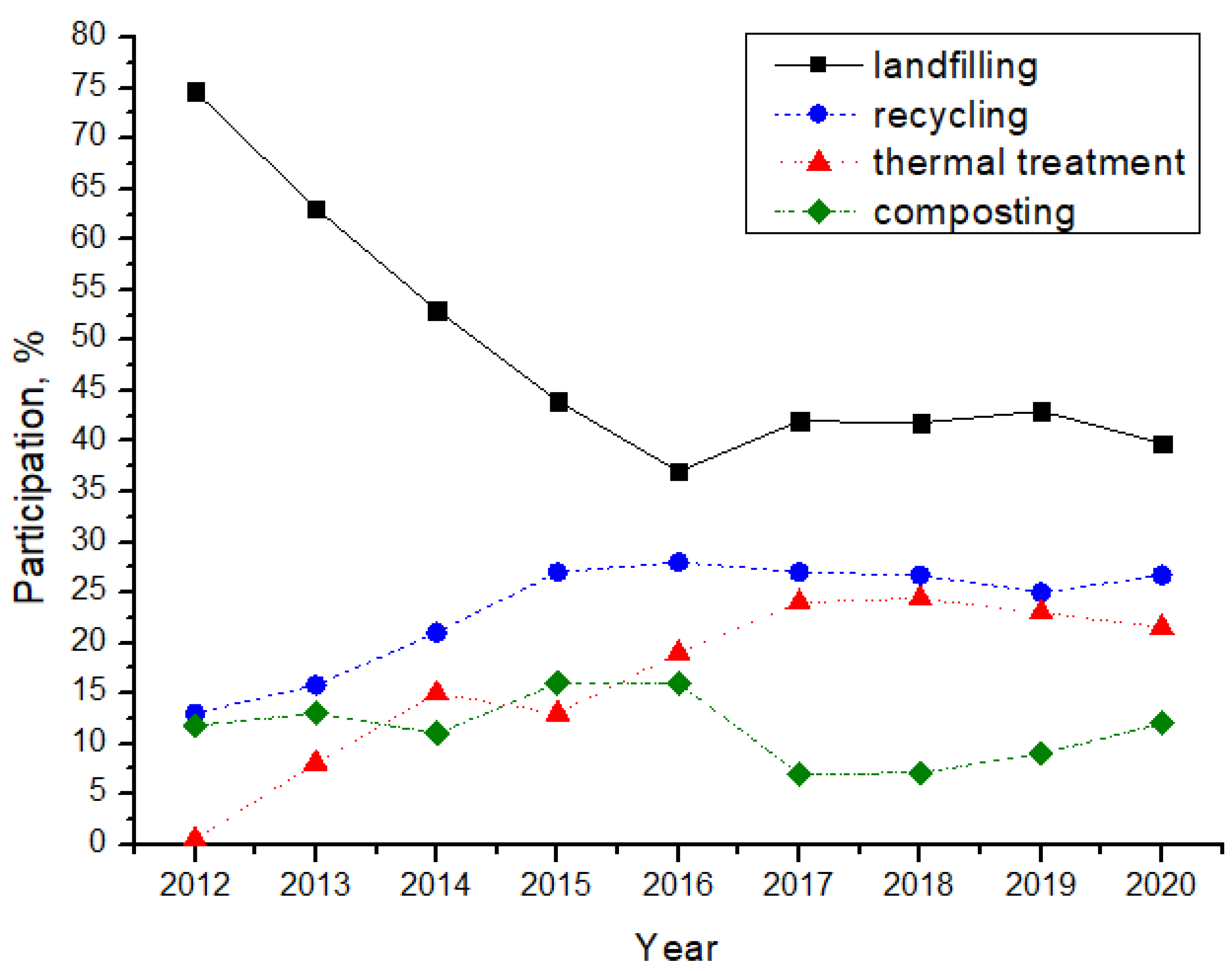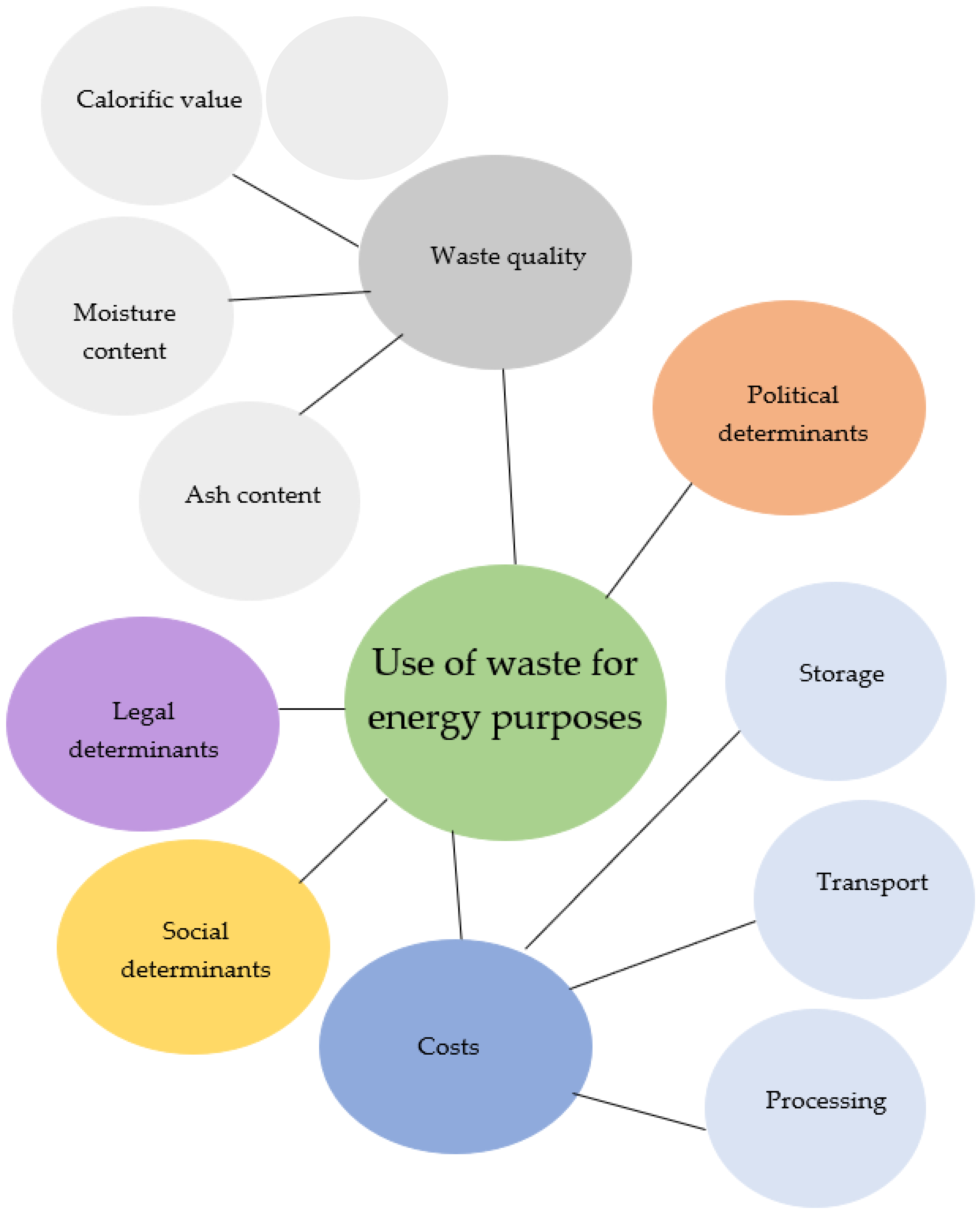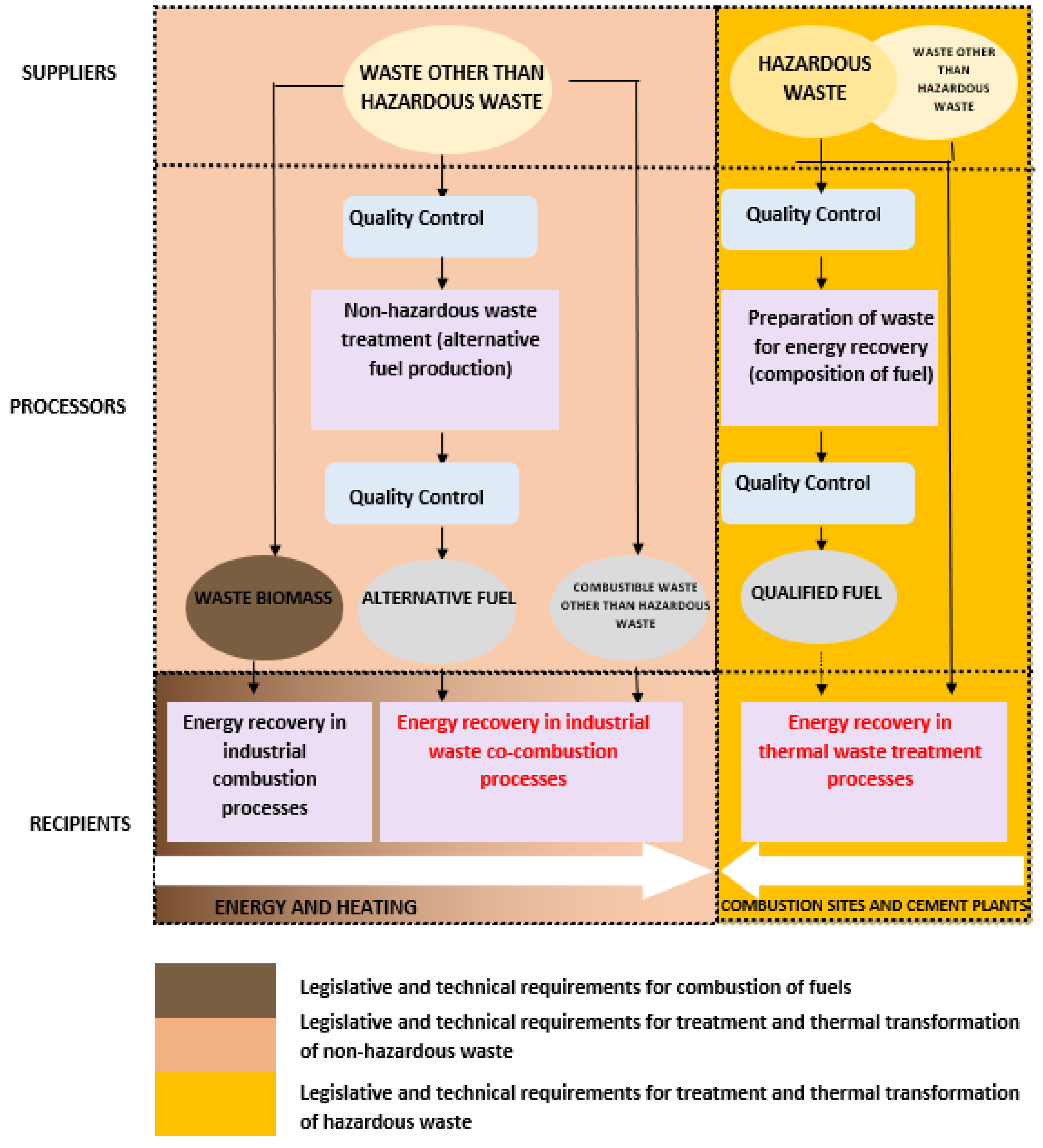Review of Selected Determinants Affecting Use of Municipal Waste for Energy Purposes
Abstract
1. Introduction
2. Theoretical Background
The State of Waste Management with the Example of Poland
3. Selected Determinants of Using Municipal Waste for Energy Purposes
3.1. Formal and Legal Possibilities of Energy Recovery from Waste with the Example of Poland
3.2. Energy Recovery from Waste—Evaluation and Review of Selected Methods Used in Thermal Transformation Processes of Municipal Waste
3.3. The Importance of Reverse Logistics for the Use of Municipal Waste for Energy Purposes
- ⮚
- substitute for decreasing fossil fuel deposits;
- ⮚
- reduction in waste storage problems, and thereby reducing greenhouse gas emissions;
- ⮚
- increased level of waste recovery;
- ⮚
- increased amount of electricity produced from renewable sources (from the biodegradable fraction contained in waste);
- ⮚
- economic benefits.
- heterogeneity of the physicochemical properties of waste;
- formal and legal approach to waste fuels as waste;
- higher requirements in terms of emission standards;
- compliance of boiler systems with the parameters required for the thermal processing of waste;
- technical and operational problems in the existing power systems (increased corrosion, increased amount of ash and difficulties with its management, a necessity for structural changes within the boiler system as well as in the flue gas purification unit;
- resistance of local communities to obtain permits for energy recovery from waste [25].
3.4. The Impact of the Pandemic and Armed Conflicts on the Possibilities of Using Municipal Waste for Energy Purposes
- ▪
- lower costs of managing the combustible fraction of municipal waste, which ensures long-term stability of the cost of this service for local governments;
- ▪
- stabilisation of residents’ fees for waste removal and management collected by municipalities;
- ▪
- improvement of air quality in Poland—a reduction in the pollutant emissions from local heating networks;
- ▪
- stabilisation of heat prices by reducing their dependence on the purchase price of CO2 emission allowances (a part of the energy from waste can be considered as renewable energy);
- ▪
- significant reduction in dependence on the import of hard coal by means of the optimum use of the combustible fraction of municipal waste. RDF is a locally produced energy resource.
4. Summary and Conclusions
Author Contributions
Funding
Data Availability Statement
Conflicts of Interest
References
- Shah, A.V.; Srivastava, V.K.; Mohanty, S.S.; Varjani, S. Municipal solid waste as a sustainable resource for energy production: State-of-the-art review. J. Environ. Chem. Eng. 2021, 9, 105717. [Google Scholar] [CrossRef]
- Kumar, A.; Samadder, S.R. A review on technological options of waste to energy for effective management of municipal solid waste. Waste Manag. 2017, 69, 407–422. [Google Scholar] [CrossRef] [PubMed]
- Central Statistical Office Główny Urząd Statystyczny. (n.d.). Available online: https://stat.gov.pl/ (accessed on 1 October 2022).
- Wielgosiński, G. Wyzwania Stojące Przed Ciepłownictwem Oraz Konkluzje BAT Dla Dużych Obiektów Energetycznego Spalania oraz ITPOK; Statistics Poland, Spatial and Environmental Surveys Department: Warsaw, Poland, 2021; pp. 1–30. [Google Scholar]
- Wielgosiński, G. Przegląd Technologii Termicznego Przekształcania Odpadów. Nowa Energ. nr 1/2011. 2011. Available online: http://www.cire.pl/item,53125,2,0,0,0,0,0,przeglad-technologii-termicznego-przeksztalcania-odpadow.html (accessed on 2 October 2022).
- Wielgosiński, G.; Czerwińska, J.; Szufa, S. Municipal solid waste mass balance as a tool for calculation of the possibility of implementing the circular economy concept. Energies 2021, 14, 1811. [Google Scholar] [CrossRef]
- Eliades, F.; Doula, M.K.; Papamichael, I.; Vardopoulos, I.; Voukkali, I.; Zorpas, A.A. Carving out a Niche in the Sustainability Confluence for Environmental Education Centers in Cyprus and Greece. Sustainability 2022, 14, 83368. [Google Scholar] [CrossRef]
- Jakubiak, M. Wdrażanie strategii i wymogów Unii Europejskiej na przykładzie wprowadzania zrównoważonej gospodarki odpadami w Polsce. Pol. Tow. Ekon. 2014, 9, 33–44. [Google Scholar]
- Variny, M.; Varga, A.; Rimár, M.; Janošovský, J.; Kizek, J.; Lukáč, L.; Jablonský, G.; Mierka, O. Advances in biomass co-combustion with fossil fuels in the European context: A review. Processes 2021, 9, 100. [Google Scholar] [CrossRef]
- Gurgul, A. Metody termiczne jako element zrównoważonej gospodarki odpadami komunalnymi w Polsce i Portugalii. In Współczesne Problemy Energetyki IV; Katedra Technologii i Urządzeń Zagospodarowania Odpadów: Gliwice, Poland, 2017; pp. 91–96. ISBN 9788393098323. [Google Scholar]
- Rajca, P. Zrównoważona gospodarka odpadami komunalnymi na przykładzie wykorzystania paliwa RDF w przemyśle cementowym. In Przyszłość Dla Biznesu, Biznes Dla Przyszłości, Monografia; Oficyna Wydawnicza Stowarzyszenia Menedżerów Jakości i Produkcji: Częstochowa, Poland, 2018; pp. 131–142. [Google Scholar]
- Mierzwiński, A.; Mierzwiński, M.; Tomaszewski, K.; Obłąkowska, K.; Moskwik, K. Przemysł Cementowy w Gospodarce Odpadami; Instytut Jagielloński: Warszawa, Poland, 2021. [Google Scholar]
- Primus, A.; Rosik-Dulewska, C. Produkcja energii w źródłach kogeneracyjnych małej mocy z wykorzystaniem technologii zgazowania odpadów pochodzenia komunalnego. Uwarunkowania prawne i ekonomiczne. Polityka Energ. 2017, 20, 79–92. [Google Scholar]
- Primus, A.C. Rosik-Dulewska Fuel potential of the oversize fraction of municipal waste and its role in the national waste management model. Zesz. Nauk. 2018, 105, 121–134. [Google Scholar] [CrossRef]
- Singh, T.; Pattnaik, P.; Aherwar, A.; Ranakoti, L.; Dogossy, G.; Lendvai, L. Optimal Design of Wood/Rice Husk-waste-Filled PLA Biocomposites Using Integrated CRITIC–MABAC-Based Decision-Making Algorithm. Polymers 2022, 14, 2603. [Google Scholar] [CrossRef]
- Malinowski, A.; Chwiałkowski, W. Characterization of Refuse Derived Fuels from Selected Municipal Solid Waste Management Plants with an example of their valorization into gas fuel and chemicals. Arch. Waste Manag. Environ. Prot. 2017, 19, 1–12. [Google Scholar]
- Hognert, J.; Nilsson, L. The small-scale production of hydrogen, with the co-production of electricity and district heat, by means of the gasification of municipal solid waste. Appl. Therm. Eng. 2016, 106, 174–179. [Google Scholar] [CrossRef]
- Edo, M.; Skoglund, N.; Gao, Q.; Persson, P.E.; Jansson, S. Fate of metals and emissions of organic pollutants from torrefaction of waste wood, MSW, and RDF. Waste Manag. 2017, 68, 646–652. [Google Scholar] [CrossRef] [PubMed]
- Grové, J.; Lant, P.A.; Greig, C.R.; Smart, S. Is MSW derived DME a viable clean cooking fuel in Kolkata, India? Renew. Energy 2018, 124, 50–60. [Google Scholar] [CrossRef]
- Chan, W.P.; Veksha, A.; Lei, J.; Oh, W.D.; Dou, X.; Giannis, A.; Lisak, G.; Lim, T.T. A novel real-time monitoring and control system for waste-to-energy gasification process employing differential temperature profiling of a downdraft gasifier. J. Environ. Manag. 2019, 234, 65–74. [Google Scholar] [CrossRef]
- Zaleski, P.; Chawla, Y. Circular economy in Poland: Profitability analysis for two methods of waste processing in small municipalities. Energies 2020, 13, 5166. [Google Scholar] [CrossRef]
- Smol, M.; Duda, J.; Czaplicka-Kotas, A.; Szołdrowska, D. Transformation towards circular economy (CE) in municipal waste management system: Model solutions for Poland. Sustainability 2020, 12, 4561. [Google Scholar] [CrossRef]
- Smol, M.; Kulczycka, J.; Czaplicka-Kotas, A.; Włóka, D. Zarządzanie i monitorowanie gospodarki odpadami komunalnymi w Polsce w kontekście realizacji gospodarki o obiegu zamkniętym (GOZ). Zesz. Nauk. Inst. Gospod. Surowcami Miner. Pol. Akad. Nauk 2019, 108, 165–184. [Google Scholar] [CrossRef]
- Wasielewski, R.; Bałazińska, M. Odzysk energii z odpadów w aspekcie kwalifikacji wytworzonej energii elektrycznej i ciepła jako pochodzących z odnawialnego źródła energii oraz uczestnictwa w systemie handlu uprawnieniami do emisji gazów cieplarnianych. Polityka Energ.-Energy Policy J. 2018, 21, 129–142. [Google Scholar]
- Wasielewski, R. Wybrane Aspekty Odzysku Energii z Odpadów w Instalacjach Energetycznych; Instytut Chemicznej Przeróbki Węgla: Zabrze, Poland, 2015; pp. 1–28. [Google Scholar]
- Bieniek, A.; Jerzak, W.; Sieradzka, M.; Mika, Ł.; Sztekler, K.; Magdziarz, A. Intermediate Pyrolysis of Brewer’s Spent Grain: Impact of Gas Atmosphere. Energies 2022, 15, 2491. [Google Scholar] [CrossRef]
- Di Giacomo, G.; Romano, P. Evolution and Prospects in Managing Sewage Sludge Resulting from Municipal Wastewater Purification. Energies 2022, 15, 5633. [Google Scholar] [CrossRef]
- Mukherjee, C.; Denney, J.; Mbonimpa, E.G.; Slagley, J.; Bhowmik, R. A review on municipal solid waste-to-energy trends in the USA. Renew. Sustain. Energy Rev. 2020, 119, 109512. [Google Scholar] [CrossRef]
- Kurniawan, T.A.; Othman Dzarfasn, M.H.; Hwang, G.H.; Gikas, P. Unlocking digital technologies for waste recycling in Industry 4.0 era: A transformation towards a digitalization-based circular economy in Indonesia. J. Clean. Prod. 2022, 357, 131911. [Google Scholar] [CrossRef]
- Malinauskaite, J.; Jouhara, H.; Czajczyńska, D.; Stanchev, P.; Katsou, E.; Rostkowski, P.; Thorne, R.J.; Colón, J.; Ponsá, S.; Al-Mansour, F.; et al. Municipal solid waste management and waste-to-energy in the context of a circular economy and energy recycling in Europe. Energy 2017, 141, 2013–2044. [Google Scholar] [CrossRef]
- Rajca, P.; Zajemska, M. Possibility of using computer simulations to identify chemical hazards during thermal conversion of fuel from RDF waste. Przem. Chem. 2019, 1, 76–78. [Google Scholar] [CrossRef]
- Gabbar, H.A.; Aboughaly, M.; Ayoub, N. Comparative study of MSW heat treatment processes and electricity generation. J. Energy Inst. 2018, 91, 481–488. [Google Scholar] [CrossRef]
- Sipra, A.T.; Gao, N.; Sarwar, H. Municipal solid waste (MSW) pyrolysis for bio-fuel production: A review of effects of MSW components and catalysts. Fuel Process. Technol. 2018, 175, 131–147. [Google Scholar] [CrossRef]
- Rajca, P. Innovative Technologies in the Development of Alternative RDF Fuel. Eng. Prot. Environ. 2018, 21, 251–260. [Google Scholar] [CrossRef]
- Wissing, F.; Wirtz, S.; Scherer, V. Simulating municipal solid waste incineration with a DEM/CFD method—Influences of waste properties, grate and furnace design. Fuel 2017, 206, 638–656. [Google Scholar] [CrossRef]
- Moya, D.; Aldás, C.; López, G.; Kaparaju, P. Municipal solid waste as a valuable renewable energy resource: A worldwide opportunity of energy recovery by using Waste-To-Energy Technologies. Energy Procedia 2017, 134, 286–295. [Google Scholar] [CrossRef]
- Dalkia Wastenergy Instalacje produkcji energii z RDF oparte na technologii DWE “ROCK” Poznań ENVICON Conference. 2020, pp. 1–19. Available online: https://portalkomunalny.pl/envicon-2020/ (accessed on 6 October 2022).
- Czajczyńska, D.; Nannou, T.; Anguilano, L.; Krzyzyńska, R.; Ghazal, H.; Spencer, N.; Jouhara, H. Potentials of pyrolysis processes in the waste management sector. Therm. Sci. Eng. Prog. 2017, 3, 171–197. [Google Scholar] [CrossRef]
- Zajemska, M.; Rajca, P.; Szwaja, S.; Morel, S. The Chemical Mechanism of the HCI Formation in the Pyrolysis Process of Selected Wastes Chemiczny mechanizm powstawania HCl w procesie pirolizy wybranych odpadów. Przem. Chem. 2019, 98, 907–910. [Google Scholar]
- Lino, F.A.M.; Ismail, K.A.R. Evaluation of the treatment of municipal solid waste as renewable energy resource in Campinas, Brazil. Sustain. Energy Technol. Assessments 2018, 29, 19–25. [Google Scholar] [CrossRef]
- Rajca, P.; Poskart, A.; Chrubasik, M.; Sajdak, M.; Zajemska, M.; Skibiński, A.; Korombel, A. Technological and economic aspect of Refuse Derived Fuel pyrolysis. Renew. Energy 2020, 161, 482–494. [Google Scholar] [CrossRef]
- Rajca, P.; Skibiński, A. Theoretical analysis of the thermal conversion of RDF fuel in the context of Waste Management. J. Phys. Conf. Ser. 2019, 1398, 012012. [Google Scholar] [CrossRef]
- Shi, H.; Mahinpey, N.; Aqsha, A.; Silbermann, R. Characterization, thermochemical conversion studies, and heating value modeling of municipal solid waste. Waste Manag. 2016, 48, 34–47. [Google Scholar] [CrossRef]
- Lombardi, L.; Carnevale, E.; Corti, A. A review of technologies and performances of thermal treatment systems for energy recovery from waste. Waste Manag. 2015, 37, 26–44. [Google Scholar] [CrossRef]
- Van Blijderveen, M.; Bramer, E.A.; Brem, G. Modelling spontaneous ignition of wood, char and RDF in a lab-scale packed bed. Fuel 2013, 108, 190–196. [Google Scholar] [CrossRef]
- Astrup, T.F.; Tonini, D.; Turconi, R.; Boldrin, A. Life cycle assessment of thermal Waste-to-Energy technologies: Review and recommendations. Waste Manag. 2015, 37, 104–115. [Google Scholar] [CrossRef]
- Wielgosiński, G.; Namiecińska, O.; Saladra, P. Thermal treatment of municipal waste in Poland in the light of new waste management plans. Nowa Energia 2017, 2, 25–30. Available online: https://nowa-energia.com.pl/2017/04/06/ne-02-2017 (accessed on 5 October 2022).
- Sieradzka, M.; Kirczuk, C.; Kalemba-rec, I.; Mlonka-mędrala, A.; Magdziarz, A. Pyrolysis of Biomass Wastes into Carbon Materials. Energies 2022, 15, 1941. [Google Scholar] [CrossRef]
- Rawat, J.; Kaalva, S.; Rathore, V.; Gokak, D.T.; Bhargava, S. Environmental Friendly Ways to Generate Renewable Energy from Municipal Solid Waste. Procedia Environ. Sci. 2016, 35, 483–490. [Google Scholar] [CrossRef]
- Bulatov, N.K.; Toilybayev, A.E.; Suleyeva, N.Z.; Sarzhanov, D.K. Development of the model (algorithm) of the efficient transportation logistics with the purpose of collection and transportation of the solid municipal waste to the places of their recycling. Environ. Dev. Sustain. 2021, 23, 2015–2037. [Google Scholar] [CrossRef]
- Colorado, D.; Echeverry, G.I.; Colorado, H. Logistics As an Essential Area for the Development of the Solid Waste Management in Colombia. Inf. Técnico 2019, 83, 131–154. [Google Scholar] [CrossRef]
- Mesjasz-Lech, A. Reverse logistics of municipal solid waste—Towards zero waste cities. Transp. Res. Procedia 2019, 39, 320–332. [Google Scholar] [CrossRef]
- Skrzyniarz, M.; Sajdak, M.; Zajemska, M.; Iwaszko, J.; Biniek-Poskart, A.; Skibiński, A.; Morel, S.; Niegodajew, P. Plastic Waste Management towards Energy Recovery during the COVID-19 Pandemic: The Example of Protective Face Mask Pyrolysis. Energies 2022, 15, 2629. [Google Scholar] [CrossRef]
- Skrzyniarz, M. Kierunki zagospodarowania odpadów z tworzyw sztucznych w dobie COVID-19. Gospod. Mater. I Logistyka 2021, 8, 25–31. [Google Scholar] [CrossRef]
- Sharma, H.B.; Vanapalli, K.R.; Cheela, V.S.; Ranjan, V.P.; Jaglan, A.K.; Dubey, B.; Goel, S.; Bhattacharya, J. Challenges, opportunities, and innovations for effective solid waste management during and post COVID-19 pandemic. Resour. Conserv. Recycl. 2020, 162, 105052. [Google Scholar] [CrossRef]
- Ragazzi, M.; Rada, E.C.; Schiavon, M. Municipal solid waste management during the SARS-CoV-2 outbreak and lockdown ease: Lessons from Italy. Sci. Total Environ. 2020, 745, 141159. [Google Scholar] [CrossRef]
- Penteado, C.S.G.; de Castro, M.A.S. COVID-19 effects on municipal solid waste management: What can effectively be done in the Brazilian scenario? Resour. Conserv. Recycl. 2021, 164, 105152. [Google Scholar] [CrossRef]
- Kulkarni, B.N.; Anantharama, V. Repercussions of COVID-19 pandemic on municipal solid waste management: Challenges and opportunities. Sci. Total Environ. 2020, 743, 140693. [Google Scholar] [CrossRef] [PubMed]
- Rada, E.C. COVID-19 and Municipal Solid Waste Management. WIT Trans. Ecol. Environ. 2022, 257, 85–96. [Google Scholar] [CrossRef]
- Gałko, G.; Sajdak, M. Trends for the Thermal Degradation of Polymeric Materials: Analysis of Available Techniques, Issues, and Opportunities. Appl. Sci. 2022, 12, 9138. [Google Scholar] [CrossRef]
- Leal Filho, W.; Salvia, A.L.; Minhas, A.; Paço, A.; Dias-Ferreira, C. The COVID-19 pandemic and single-use plastic waste in households: A preliminary study. Sci. Total Environ. 2021, 793, 148571. [Google Scholar] [CrossRef]
- Dharmaraj, S.; Ashokkumar, V.; Pandiyan, R.; Halimatul Munawaroh, H.S.; Chew, K.W.; Chen, W.H.; Ngamcharussrivichai, C. Pyrolysis: An effective technique for degradation of COVID-19 medical wastes. Chemosphere 2021, 275, 130092. [Google Scholar] [CrossRef]
- Vanapalli, K.R.; Sharma, H.B.; Ranjan, V.P.; Samal, B.; Bhattacharya, J.; Dubey, B.K.; Goel, S. Challenges and strategies for effective plastic waste management during and post COVID-19 pandemic. Sci. Total Environ. 2021, 750, 141514. [Google Scholar] [CrossRef]
- da Silva Mateus, A.; Serafim Francisco, A.P.; Franciosco, P.; Manuel, N. Thermocatalytic Cracking of Frying Oil and Plastic Waste for Production of Organic Liquid Products and Derivatives. Chem. Eng. Technol. 2022, 45, 1835–1841. [Google Scholar] [CrossRef]
- Leśniewski, B. Polskie odpady zamiast węgla Putina. Przegląd Komunalny 2022, 5, 7–12. Available online: https://portalkomunalny.pl/plus/artykul/polskie-odpady-zamiast-wegla-putina/ (accessed on 4 October 2022).





| No. | Size | Unit | Permissible Value | Available Syngas Purification Methods |
|---|---|---|---|---|
| 1. | Hydrogen sulphide content | mg/Nm3 | 7.0 | methods: wet alkaline absorption |
| 2. | Mercaptan sulphur content | mg/Nm3 | 16.0 | |
| 3. | Total sulphur content | mg/Nm3 | 40.0 | |
| 4. | Mercury vapour content | µg/Nm3 | 30.0 | adsorption on activated carbon |
| 5. | Oxygen content not greater than | % (mol/mol) | 0.2 | control of the gasification process, technological requirements |
| 6. | Dust content greater than 5 μm in diameter | mg/Nm3 | 1 | combined methods—centrifugal separation, fabric filtration, granular filters, absorption in wet methods |
| 7. | Content of hydrocarbons that can be condensed at −5 °C at pressure prevailing in gas pipeline 1 | mg/Nm3 | 30 | combined methods—catalytic and thermal destruction, condensation in shock cooling methods, filtration through oil and granular filters and adsorption by activated carbon |
| Municipal Waste | RDF | ||||
|---|---|---|---|---|---|
| Hognert et al. [17] | Edo et al. [18] | Grove et al. [19] | Chan et al. [20] | Edo et al. [18] | |
| Coal [%] | 48.00 | 49.00 | 53.00 | 56.30 | 52.00 |
| Hydrogen [%] | 6.00 | 6.30 | 6.80 | 8.40 | 6.60 |
| Nitrogen [%] | 0.20 | 0.90 | 2.20 | 1.10 | 0.18 |
| Sulphur [%] | 0.10 | 0.08 | 0.30 | 0.30 | <0.02 |
| Chlorine [%] | 0.9 | 0.47 | - | 1.10 | 0.10 |
| Oxygen [%] | 38.00 | 35.00 | 37.80 | 25.40 | 38.00 |
| Moisture content [%] | 34.00 | 0.00 | 38.40 | 0.00 | 0.00 |
| Ash content [%] | 8.00 | 8.20 | 33.50 | 8.50 | 3.40 |
| Calorific value [MJ/kg] | 11.30 | 18.60 | 4.50 | 23.00 | 19.80 |
| Rotating/Oscillating Combustion Kiln (ROCK) | Pyrolysis | Gasification |
|---|---|---|
|
|
|
| Before the Pandemic | During the Pandemic | After the Pandemic |
|---|---|---|
|
|
|
Publisher’s Note: MDPI stays neutral with regard to jurisdictional claims in published maps and institutional affiliations. |
© 2022 by the authors. Licensee MDPI, Basel, Switzerland. This article is an open access article distributed under the terms and conditions of the Creative Commons Attribution (CC BY) license (https://creativecommons.org/licenses/by/4.0/).
Share and Cite
Rajca, P.; Skibiński, A.; Biniek-Poskart, A.; Zajemska, M. Review of Selected Determinants Affecting Use of Municipal Waste for Energy Purposes. Energies 2022, 15, 9057. https://doi.org/10.3390/en15239057
Rajca P, Skibiński A, Biniek-Poskart A, Zajemska M. Review of Selected Determinants Affecting Use of Municipal Waste for Energy Purposes. Energies. 2022; 15(23):9057. https://doi.org/10.3390/en15239057
Chicago/Turabian StyleRajca, Przemysław, Andrzej Skibiński, Anna Biniek-Poskart, and Monika Zajemska. 2022. "Review of Selected Determinants Affecting Use of Municipal Waste for Energy Purposes" Energies 15, no. 23: 9057. https://doi.org/10.3390/en15239057
APA StyleRajca, P., Skibiński, A., Biniek-Poskart, A., & Zajemska, M. (2022). Review of Selected Determinants Affecting Use of Municipal Waste for Energy Purposes. Energies, 15(23), 9057. https://doi.org/10.3390/en15239057







